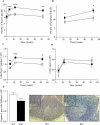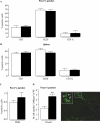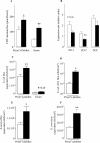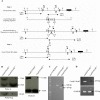CARD15/NOD2 is required for Peyer's patches homeostasis in mice
- PMID: 17565376
- PMCID: PMC1885825
- DOI: 10.1371/journal.pone.0000523
CARD15/NOD2 is required for Peyer's patches homeostasis in mice
Abstract
Background: CARD15/NOD2 mutations are associated with susceptibility to Crohn's Disease (CD) and Graft Versus Host Disease (GVHD). CD and GVHD are suspected to be related with the dysfunction of Peyer's patches (PP) and isolated lymphoid follicles (LFs). Using a new mouse model invalidated for Card15/Nod2 (KO), we thus analysed the impact of the gene in these lymphoid formations together with the development of experimental colitis.
Methodology/principal findings: At weeks 4, 12 and 52, the numbers of PPs and LFs were higher in KO mice while no difference was observed at birth. At weeks 4 and 12, the size and cellular composition of PPs were analysed by flow cytometry and immunohistochemistry. PPs of KO mice were larger with an increased proportion of M cells and CD4(+) T-cells. KO mice were also characterised by higher concentrations of TNFalpha, IFNgamma, IL12 and IL4 measured by ELISA. In contrast, little differences were found in the PP-free ileum and the spleen of KO mice. By using chamber experiments, we found that this PP phenotype is associated with an increased of both paracellular permeability and yeast/bacterial translocation. Finally, KO mice were more susceptible to the colitis induced by TNBS.
Conclusions: Card15/Nod2 deficiency induces an abnormal development and function of the PPs characterised by an exaggerated immune response and an increased permeability. These observations provide a comprehensive link between the molecular defect and the Human CARD15/NOD2 associated disorders: CD and GVHD.
Conflict of interest statement
Figures







References
-
- Hugot JP, Chamaillard M, Zouali H, Lesage S, Cezard JP, et al. Association of NOD2 leucine-rich repeat variants with susceptibility to Crohn's disease. Nature. 2001;411:599–603. - PubMed
-
- Ogura Y, Bonen DK, Inohara N, Nicolae DL, Chen FF, et al. A frameshift mutation in NOD2 associated with susceptibility to Crohn's disease. Nature. 2001;411:603–606. - PubMed
-
- Holler E, Rogler G, Herfarth H, Brenmoehl J, Wild PJ, et al. Both donor and recipient NOD2/CARD15 mutations associate with transplant-related mortality and GvHD following allogeneic stem cell transplantation. Blood. 2004;104:889–894. - PubMed
-
- Elmaagacli AH, Koldehoff M, Hindahl H, Steckel NK, Trenschel R, et al. Mutations in innate immune system NOD2/CARD 15 and TLR-4 (Thr399Ile) genes influence the risk for severe acute graft-versus-host disease in patients who underwent an allogeneic transplantation. Transplantation. 2006;81:247–254. - PubMed
-
- Inohara N, Nunez G. NODs: intracellular proteins involved in inflammation and apoptosis. Nat Rev Immunol. 2003;3:371–382. - PubMed
Publication types
MeSH terms
Substances
LinkOut - more resources
Full Text Sources
Other Literature Sources
Molecular Biology Databases
Research Materials
Miscellaneous

